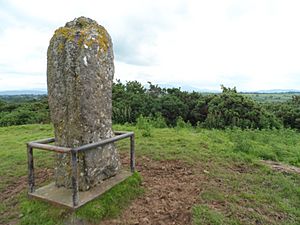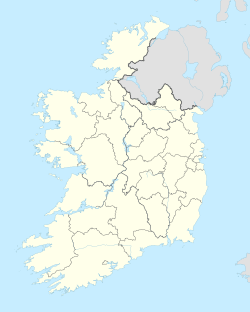Longstone Rath facts for kids
|
Ráth na Cloiche Fada
|
|

Longstone viewed in situ.
|
|
| Location | Longstone, Cullen, County Tipperary, Ireland |
|---|---|
| Region | Munster |
| Coordinates | 52°30′22″N 8°17′52″W / 52.506051°N 8.297753°W |
| Area | 2,400 m2 (0.6 acre) |
| Diameter | 55 m (60 yd) |
| History | |
| Material | earth, limestone |
| Founded | 1 AD |
| Periods | Iron Age |
| Site notes | |
| Excavation dates | 1973–76 |
| Designation | National Monument |
Longstone Rath (which means Ráth na Cloiche Fada in Irish) is an ancient site in County Tipperary, Ireland. It is a type of old fort called a ringfort or rath. Today, it is protected as a National Monument.
Contents
Where is Longstone Rath?
Longstone Rath is found on a hill. From this spot, you can see the road between Barna and Emly. It is about 1.6 kilometers (1 mile) southwest of Cullen.
History of Longstone Rath
Longstone Rath is a very interesting historical place. It has a tall stone and an old fort. People have used this hilltop for thousands of years.
The Longstone and the Rath
At the site, you will see a large limestone rock. This rock is called a "longstone." It stands about 2.3 meters (7 feet 7 inches) tall. The longstone is on top of a small hill. This hill is inside a ringfort. A ringfort is a circular fort made of earth. This one is "bivallate," meaning it has two protective banks or walls.
Scientists believe the hill with the longstone was built around 1 AD. This was during the middle of the Iron Age. The ringfort (rath) was added much later, around 600 AD.
What Was Found at the Site?
Archaeologists are like history detectives. They dug up Longstone Rath between 1973 and 1976. They found many clues about the past.
Here are some of the things they discovered:
- Over 4,000 pieces of broken pottery, called potsherds.
- Six whole pottery pots.
- More than 400 flint scrapers. These were tools used for cleaning animal hides.
- Bones that had been burned, which tells us about ancient burial customs.
- Special pottery called grooved ware.
A Place Used for Thousands of Years
Experts believe Longstone Rath was a "halting site." This means it was a place where different groups of people stopped and stayed for a while. This happened over many thousands of years.
For example, archaeologists found bowls similar to those from the Carrowkeel Megalithic Cemetery. This suggests that people who built large stone tombs (called "passage-tomb folk") might have camped here.
Later, other ancient groups also used the hilltop. These included people from the Beaker culture, Food Vessel culture, and Urnfield culture. This shows that the site was important to many different groups long before the longstone and the fort were built.


